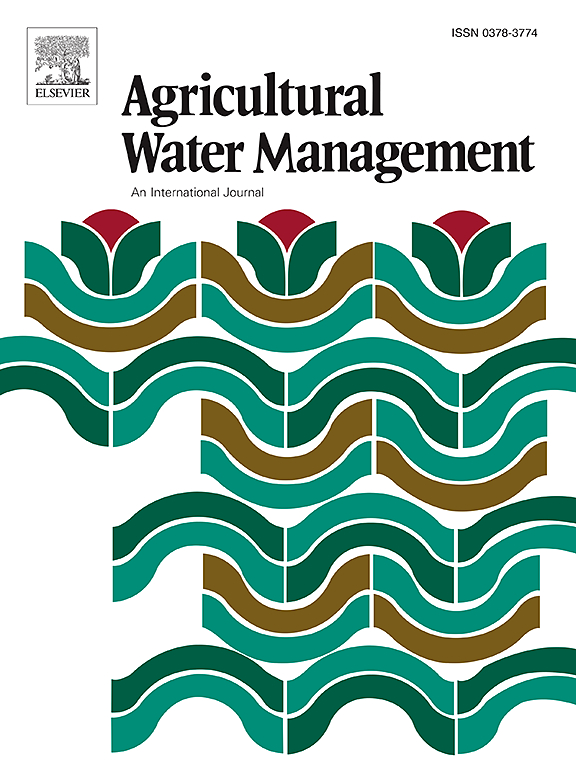苏丹杰济拉灌溉计划中土地和水生产力的多尺度空间变异性
IF 5.9
1区 农林科学
Q1 AGRONOMY
引用次数: 0
摘要
农业绩效评估跨越不同的空间尺度,从单一地块到整个灌溉系统。因此,多尺度分析对于知情决策至关重要。苏丹的杰济拉灌溉系统是一个历史悠久的大型灌溉系统,面临着严峻的水资源管理挑战,表现为土地生产力、水生产力和灌溉效率低下。认识到决策的相互依存性,本研究重点关注杰济拉灌溉系统内不同空间尺度上水和土地生产力的变化。作为世界上最大的重力灌溉系统之一,该系统覆盖 210 万费丹(1 费丹 = 0.42 公顷 ∼ 1 英亩),是研究三级、二级、主要单元和整个系统四个空间尺度的首尾性能变化的有趣案例。本研究以 2022-2023 年冬季小麦种植为中心,采用粮农组织水生产力开放门户(WaPOR v2.1)数据集计算水土生产力,分辨率为 100 米。Wadelbur 灌区九个三级单元(nimras)的地面观测产量数据被用来验证 WaPOR。结果显示,与地面数据集相比,WaPOR 得出的土地生产力系统性低估了约 40%。对土地和水生产力的头尾分析显示,不同尺度的结果截然不同。在三级和二级尺度上,离取水口的距离与生产率之间不存在相关性。在主要单位(灌溉分区)上,可以观察到中等程度的相关性:土地生产率为 0.7,水生产率为 0.6。在计划规模上,土地生产率的相关系数略低(0.4),水生产率的相关系数相同(0.6)。在最大尺度上,生产率似乎从地头向地尾递增,这表明地头部分可能存在过度灌溉和内涝,从而导致生产率降低。另一种可能是尾部地区的农业耕作方式优于头部地区。本文章由计算机程序翻译,如有差异,请以英文原文为准。
Multiscale spatial variability in land and water productivity across the Gezira irrigation scheme, Sudan
Agricultural performance assessment spans various spatial scales, from single plots to entire irrigation systems. A multi-scale analysis is thus crucial for informed decision-making. The Gezira irrigation sScheme in Sudan is a longstanding large-scale irrigation system experiencing severe water management challenges, manifested by low land productivity, water productivity, and irrigation efficiency. Recognizing the interdependence of decision-making, this research focuses on variations in water and land productivity at different spatial scales within the Gezira irrigation scheme. As one of the world’s largest gravity-irrigated systems, covering 2.1 million feddan (1 feddan = 0.42 ha ∼ 1 acre), the scheme serves as an interesting case to study head-tail performance variations across four spatial scales: tertiary, secondary, and major units, and the whole scheme. This study is centered on the winter season wheat cultivation 2022–2023, and employs the FAO’s Water Productivity Open Access Portal (WaPOR v2.1) datasets, with 100 m resolution, for computing land and water productivity. Ground-observed yield data from nine tertiary units (nimras) in the Wadelbur irrigation division were used to validate WaPOR. The results showed a systematic underestimation of WaPOR derived land productivity by about 40 % compared to the ground dataset. The head-tail analysis of land and water productivity reveal contrasting results at different scales. At tertiary and secondary scales, no correlation exists between distance from offtake and productivity. At the major unit (irrigation division), a moderate correlation is observed: 0.7 for land productivity, and 0.6 for water productivity. At the scheme scale, the correlation factors are somewhat lower for land productivity (0.4) and the same for water productivity (0.6). At the largest scale, the productivity appears to increase from head to tail divisions, suggesting potential overirrigation and waterlogging in the head parts leading to reduced productivity. Another possibility is the presence of better agricultural practices in the tail areas compared to the head.
求助全文
通过发布文献求助,成功后即可免费获取论文全文。
去求助
来源期刊

Agricultural Water Management
农林科学-农艺学
CiteScore
12.10
自引率
14.90%
发文量
648
审稿时长
4.9 months
期刊介绍:
Agricultural Water Management publishes papers of international significance relating to the science, economics, and policy of agricultural water management. In all cases, manuscripts must address implications and provide insight regarding agricultural water management.
 求助内容:
求助内容: 应助结果提醒方式:
应助结果提醒方式:


